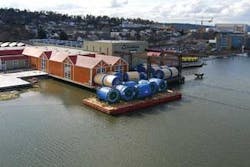Manufacturing technique improves accuracy of polyester rope deliveries
Nick Terdre - Contributing Editor
Parker Scanrope’s response to requests from installation contractors for more accurate length measurement of its polyester mooring lines is to incorporate additional equipment into the manufacturing process. Rope produced using the new method has been supplied to the Perdido project in the Gulf of Mexico and also will be delivered to a drilling rig working off Angola.
The development comes against a background of steady expansion in the use of polyester mooring ropes, especially in deepwater where it significantly reduces the loading on the moored structure. Used in combination with chain or wire, the rope constitutes the greater part of the mooring, so having a precise estimate of its length is important.
Parker Scanrope has introduced a new method to measure length whereby the rope is manufactured at a constant tension of 1% of the minimum breaking load (MBL), the reference tension specified by many classification societies and international standards bodies for rope prototype testing. For deepwater moorings, the MBL can be up to 2,500 metric tons (2,756 tons), so during manufacture the rope would be tensioned to 25 metric tons (27.56 tons).
Previously, the length of a segment of polyester mooring rope was determined by two methods, says Parker Scanrope’s design engineer, Neil Schulz. One method involves weighing the completed segment and then dividing it by the actual weight of a meter of rope. However, the results can be affected by humidity in the air which can lead to inaccuracy.
The other method is to use a measuring device during production at machine tension which is typically 2 metric tons (2.2 tons). An extension factor then is applied from machine tension to 1% MBL. However, polyester rope has an elastic behavior, and at low loads a small variation in load can yield a high variation in extension. Care must be taken when testing and calculating extension factors as this can lead to higher inaccuracy, says Schulz.
The new equipment added to the manufacturing process, known as the Ruler, comprises two winches through which the rope is passed after it has been braided. Each winch consists of a set of six individually driven sheaves. The first winch runs at the same speed as the rope production while the second winch is torque-controlled to give a pre-determined tension in the rope. This tension is measured constantly by a load cell fitted to the winch – if the load falls below the reference level, the pull on the rope is increased to raise the load, and vice versa if the load becomes too great.
Prototype tests are performed on a section of the rope as part of the rope qualification process. These tests normally include a change-in-length verification test starting from a reference load of 1% MBL, this being the supplied load from Parker Scanrope. The test results make it possible to determine the length of the supplied rope to any tension above 1% MBL as per the test procedure.
The first delivery of rope manufactured with the aid of the Ruler was made this year to Shell’s Perdido development in the Gulf of Mexico, where it has been used to moor the world’s deepest spar production platform, in more than 8,000 ft (2,438 m) of water. It is also the deepest installation of a polyester rope mooring system, Schulz says.
The mooring operation was carried out by Technip, which also was responsible for designing and building the field’s spar hull. Following installation in August, Scanrope will receive data from Technip on the measurement of the rope in as-installed condition performed by an ROV. This will verify whether the new length measurement procedure satisfies the objectives, says Schulz.
Parker Scanrope is using the new method for a delivery of polyester rope to mooring contractor InterMoor, to moor Seadrill’sWest Setia semisubmersible tender drilling rig. In March 2009, the rig is scheduled to start a three-year development drilling assignment on Chevron’s Tombua Landana field in block 14 off Angola. It will be moored with eight legs in a water depth of around 1,200 ft (366 m).
The rope design for this project is Scanrope’s TorqueMatch. This is a rope construction designed to match the torque of the wire it is connected to, thereby increasing the wire’s fatigue life. The company’s other main rope mooring product is MoorLine, a torque-neutral construction, which was the type supplied to Perdido. Manufacturing takes place at the company’s facility in Tønsberg, Norway.


